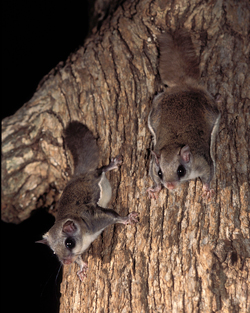
By Dan Zarlenga,
Missouri Department of Conservation
Photo caption: A pair of southern flying squirrels seem ready to take off on a night flight.
Photo courtesy of the Missouri Department of Conservation
Nothing says February like those fabulous flying squirrels. At least that’s the case if you’re a nocturnal nature lover.
Southern flying squirrels are the overnight shift workers of the squirrel family. They take over after their cousins, the grey and fox squirrels, go to bed. In fact, they are only active after the sun goes down, spending the daylight hours sleeping inside hollows of trees or under loose bark.
February is a big deal to flying squirrels because they begin breeding toward the end of the month. Due to their increased activity, anyone keen to venture out at night might have a greater chance of catching a glimpse of these forest fliers this time of year. After mating, the female gives birth to four to six babies in the spring, with a second litter sometimes arriving in late summer.
Flying squirrels are about the size of a chipmunk. Aside from their huge dark eyes that help them see at night, a flying squirrel’s facial features are very reminiscent of a mouse. They dwell in mature forests with a lot of old dead or rotten trees, which often have woodpecker holes. They like to live in these and can make do with an opening as small as a quarter. Flying squirrels are omnivores, meaning they’ll feast on anything from nuts, mushrooms, fruits, berries, and tree bark, to insects like moths and beetles. They will even visit bird feeders.
It turns out that these flying squirrels don’t actually fly, but they are fabulous, nonetheless. In reality, these squirrels are more like gliders. To facilitate their nighttime “flights”, they have a large membrane of skin that stretches from the wrists to the ankles on either side of their bodies. A smaller membrane runs between the ankles and the tail. This creates a natural parachute that the squirrel uses to glide to Earth after leaping from a tree. The flying squirrel takes off from a branch and can sail through the air, with its long legs spread and parachute open, up to 150 feet at speeds of 20 miles per hour.
Upward-turned cartilage at the tips of each wing perform the same function as winglets on the ends of airplane wings, giving the flying squirrel more stability and reducing drag. It wiggles its hands and feet from side to side to control the rate of decent, and the animal’s flat tail helps it maneuver, and even execute 180-degree turns. The most fabulous thing of all is that the flying squirrel accomplishes this without a single flying lesson—it’s all pure instinct.
It could be worth going out on a nighttime adventure of your own to look for these sailing squirrels. Keep a careful eye out and you might just be able to make out a tiny furplane coming in for a landing in the moonlight’s silvery glow. If so, you’ve just seen a fabulous flying squirrel taking nature’s red-eye flight.


